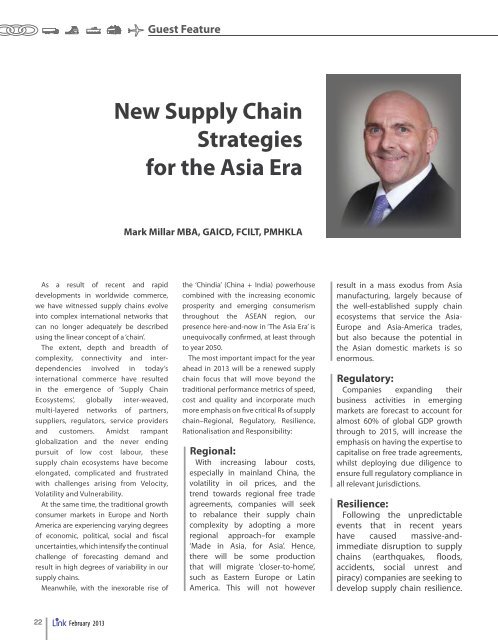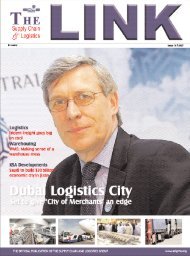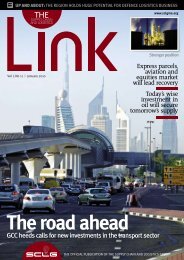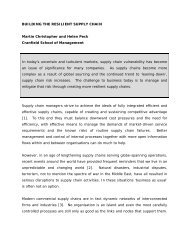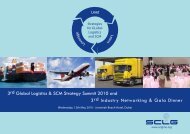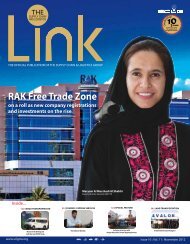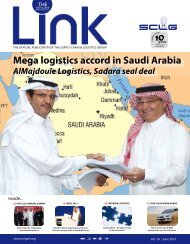Material Handling Equipment Material Handling Equipment - SCLG
Material Handling Equipment Material Handling Equipment - SCLG
Material Handling Equipment Material Handling Equipment - SCLG
Create successful ePaper yourself
Turn your PDF publications into a flip-book with our unique Google optimized e-Paper software.
Guest Feature<br />
New Supply Chain<br />
Strategies<br />
for the Asia Era<br />
Mark Millar MBA, GAICD, FCILT, PMHKLA<br />
As a result of recent and rapid<br />
developments in worldwide commerce,<br />
we have witnessed supply chains evolve<br />
into complex international networks that<br />
can no longer adequately be described<br />
using the linear concept of a ‘chain’.<br />
The extent, depth and breadth of<br />
complexity, connectivity and interdependencies<br />
involved in today’s<br />
international commerce have resulted<br />
in the emergence of ‘Supply Chain<br />
Ecosystems’, globally inter-weaved,<br />
multi-layered networks of partners,<br />
suppliers, regulators, service providers<br />
and customers. Amidst rampant<br />
globalization and the never ending<br />
pursuit of low cost labour, these<br />
supply chain ecosystems have become<br />
elongated, complicated and frustrated<br />
with challenges arising from Velocity,<br />
Volatility and Vulnerability.<br />
At the same time, the traditional growth<br />
consumer markets in Europe and North<br />
America are experiencing varying degrees<br />
of economic, political, social and fiscal<br />
uncertainties, which intensify the continual<br />
challenge of forecasting demand and<br />
result in high degrees of variability in our<br />
supply chains.<br />
Meanwhile, with the inexorable rise of<br />
the ‘Chindia’ (China + India) powerhouse<br />
combined with the increasing economic<br />
prosperity and emerging consumerism<br />
throughout the ASEAN region, our<br />
presence here-and-now in ‘The Asia Era’ is<br />
unequivocally confirmed, at least through<br />
to year 2050.<br />
The most important impact for the year<br />
ahead in 2013 will be a renewed supply<br />
chain focus that will move beyond the<br />
traditional performance metrics of speed,<br />
cost and quality and incorporate much<br />
more emphasis on five critical Rs of supply<br />
chain–Regional, Regulatory, Resilience,<br />
Rationalisation and Responsibility:<br />
Regional:<br />
With increasing labour costs,<br />
especially in mainland China, the<br />
volatility in oil prices, and the<br />
trend towards regional free trade<br />
agreements, companies will seek<br />
to rebalance their supply chain<br />
complexity by adopting a more<br />
regional approach–for example<br />
‘Made in Asia, for Asia’. Hence,<br />
there will be some production<br />
that will migrate ‘closer-to-home’,<br />
such as Eastern Europe or Latin<br />
America. This will not however<br />
result in a mass exodus from Asia<br />
manufacturing, largely because of<br />
the well-established supply chain<br />
ecosystems that service the Asia-<br />
Europe and Asia-America trades,<br />
but also because the potential in<br />
the Asian domestic markets is so<br />
enormous.<br />
Regulatory:<br />
Companies expanding their<br />
business activities in emerging<br />
markets are forecast to account for<br />
almost 60% of global GDP growth<br />
through to 2015, will increase the<br />
emphasis on having the expertise to<br />
capitalise on free trade agreements,<br />
whilst deploying due diligence to<br />
ensure full regulatory compliance in<br />
all relevant jurisdictions.<br />
Resilience:<br />
Following the unpredictable<br />
events that in recent years<br />
have caused massive-andimmediate<br />
disruption to supply<br />
chains (earthquakes, floods,<br />
accidents, social unrest and<br />
piracy) companies are seeking to<br />
develop supply chain resilience.<br />
22 February 2013


